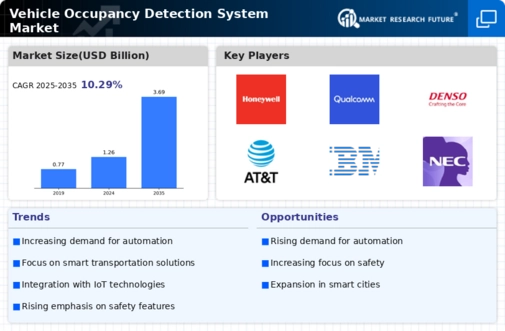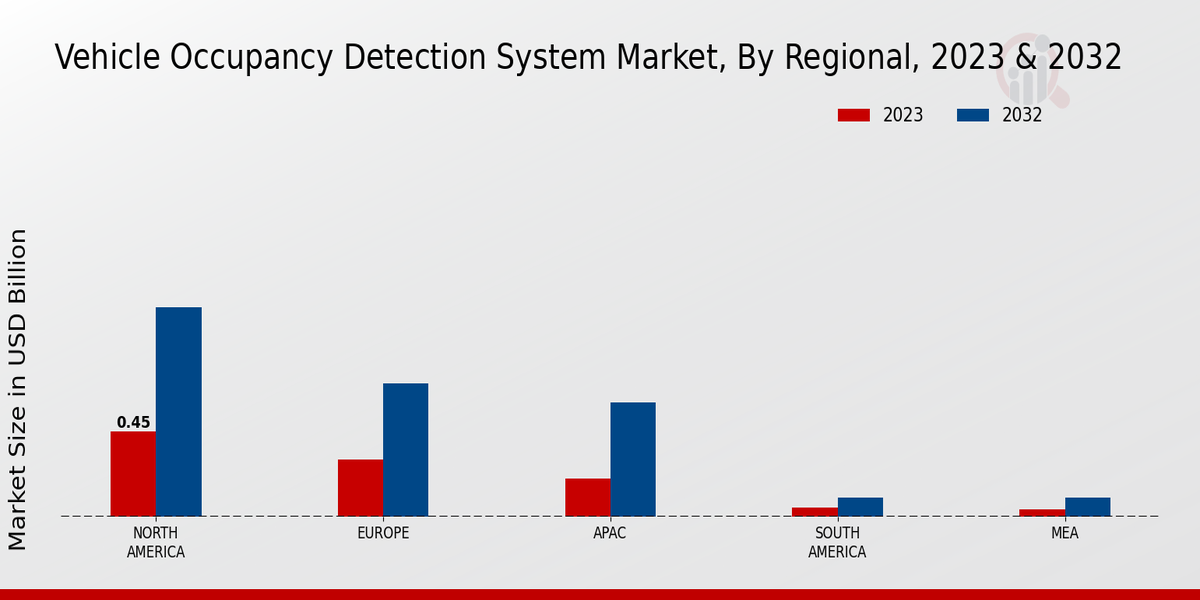Market Growth Projections
The Global Vehicle Occupancy Detection System Market Industry is projected to experience robust growth in the coming years. With an expected market size of 1.26 USD Billion in 2024, the industry is on a trajectory to reach 3.69 USD Billion by 2035. This growth is underpinned by a compound annual growth rate of 10.27% from 2025 to 2035. The increasing adoption of smart transportation solutions, coupled with government regulations and technological advancements, is likely to drive this expansion. As urban areas continue to evolve, the demand for efficient vehicle occupancy detection systems will become increasingly critical for sustainable urban mobility.
Government Initiatives and Regulations
Government initiatives and regulations play a pivotal role in shaping the Global Vehicle Occupancy Detection System Market Industry. Many countries are implementing policies aimed at reducing traffic congestion and promoting public transportation. For example, the European Union has set ambitious targets for reducing greenhouse gas emissions, which encourages the adoption of vehicle occupancy detection systems. These systems facilitate better monitoring of vehicle usage, thereby supporting regulatory compliance. As a result, the market is expected to witness substantial growth, with projections indicating a rise to 3.69 USD Billion by 2035, reflecting the increasing emphasis on sustainable transportation solutions.
Rising Focus on Environmental Sustainability
The rising focus on environmental sustainability is a key driver for the Global Vehicle Occupancy Detection System Market Industry. As awareness of climate change and pollution grows, there is a concerted effort to reduce vehicular emissions. Vehicle occupancy detection systems enable more efficient use of public transport, thereby decreasing the number of vehicles on the road. This shift is supported by various international agreements aimed at reducing carbon footprints. Consequently, the market is anticipated to grow at a compound annual growth rate of 10.27% from 2025 to 2035, reflecting the increasing demand for eco-friendly transportation solutions.
Growing Demand for Smart Transportation Solutions
The Global Vehicle Occupancy Detection System Market Industry is experiencing a surge in demand for smart transportation solutions. As urbanization accelerates, cities are increasingly adopting intelligent traffic management systems to enhance mobility and reduce congestion. For instance, cities like Singapore and Amsterdam have implemented advanced vehicle occupancy detection systems to optimize public transport usage. This trend is projected to contribute to the market's growth, with the industry expected to reach 1.26 USD Billion in 2024. The integration of these systems into smart city initiatives is likely to drive further adoption, as municipalities seek to improve efficiency and sustainability.
Technological Advancements in Sensor Technologies
Technological advancements in sensor technologies are significantly influencing the Global Vehicle Occupancy Detection System Market Industry. Innovations in infrared, ultrasonic, and radar sensors are enhancing the accuracy and reliability of occupancy detection systems. For instance, the deployment of LiDAR technology has improved the ability to monitor vehicle occupancy in real-time. These advancements not only increase the efficiency of public transport systems but also contribute to better traffic management. As the market evolves, the integration of artificial intelligence and machine learning with these technologies is expected to further enhance system capabilities, driving growth in the coming years.
Increased Investment in Public Transportation Infrastructure
Increased investment in public transportation infrastructure is driving the Global Vehicle Occupancy Detection System Market Industry. Governments and private entities are recognizing the need for modernized transport systems to accommodate growing populations. For instance, cities like Los Angeles and New York are investing heavily in upgrading their transit systems, which includes the integration of vehicle occupancy detection technologies. This investment not only enhances the efficiency of public transport but also improves user experience. As a result, the market is poised for significant growth, with projections indicating a substantial increase in revenue as these systems become integral to urban transport planning.














